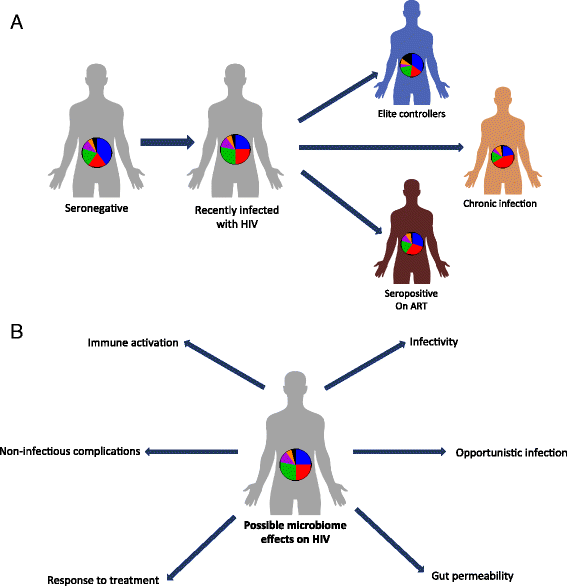The gut microbiome in human immunodeficiency virus infection - PubMed (original) (raw)
Review
The gut microbiome in human immunodeficiency virus infection
Gili Zilberman-Schapira et al. BMC Med. 2016.
Abstract
HIV/AIDS causes severe dysfunction of the immune system through CD4+ T cell depletion, leading to dysregulation of both the adaptive and innate immune arms. A primary target for viral infection is the gastrointestinal tract, which is a reservoir of CD4+ T cells. In addition to being a major immune hub, the human gastrointestinal tract harbors trillions of commensal microorganisms, the microbiota, which have recently been shown to play critical roles in health. Alterations in the composition and function of microbiota have been implicated in a variety of 'multi-factorial' disorders, including infectious, autoimmune, metabolic, and neoplastic disorders. It is widely accepted that, in addition to its direct role in altering the gastrointestinal CD4+ T cell compartment, HIV infection is characterized by gut microbiota compositional and functional changes. Herein, we review such alterations and discuss their potential local and systemic effects on the HIV-positive host, as well as potential roles of novel microbiota-targeting treatments in modulating HIV progression and associated adverse systemic manifestations.
Keywords: AIDS; Anti-retroviral therapy; CD4+ T cells; Dysbiosis; Gastrointestinal tract; HIV; Microbiota.
Figures
Fig. 1
Gut microbiota alterations during HIV infection and their potential effects on the host. a. In different studies, distinct gut microbiome compositions have been identified in HIV infected individuals with or without ART, as compared to healthy controls. Importantly, HIV-associated microbiome configurations vary between these studies. While ART dramatically lowers the viral load in infected individuals, gut microbiome composition is not fully restored to a healthy composition. ‘Elite controllers’ differ in their microbial composition from HIV- infected individuals and are more similar to healthy individuals. b. The characteristic HIV microbiota possibly contributes to some of the common HIV manifestations, including modification of the level if infectivity, occurrence of opportunistic infections, increased gut permeability and resultant bacteria and bacterial product translocation, increased immune activation and T cell polarization, metabolic complications and variability in the response to HIV treatment
Similar articles
- Altered Gut Microbiota in HIV Infection: Future Perspective of Fecal Microbiota Transplantation Therapy.
Kang Y, Cai Y. Kang Y, et al. AIDS Res Hum Retroviruses. 2019 Mar;35(3):229-235. doi: 10.1089/AID.2017.0268. Epub 2018 Jul 9. AIDS Res Hum Retroviruses. 2019. PMID: 29877092 Review. - Unique Gut Microbiome in HIV Patients on Antiretroviral Therapy (ART) Suggests Association with Chronic Inflammation.
Ishizaka A, Koga M, Mizutani T, Parbie PK, Prawisuda D, Yusa N, Sedohara A, Kikuchi T, Ikeuchi K, Adachi E, Koibuchi T, Furukawa Y, Tojo A, Imoto S, Suzuki Y, Tsutsumi T, Kiyono H, Matano T, Yotsuyanagi H. Ishizaka A, et al. Microbiol Spectr. 2021 Sep 3;9(1):e0070821. doi: 10.1128/Spectrum.00708-21. Epub 2021 Aug 11. Microbiol Spectr. 2021. PMID: 34378948 Free PMC article. - Gut Mucosal Barrier Dysfunction, Microbial Dysbiosis, and Their Role in HIV-1 Disease Progression.
Mudd JC, Brenchley JM. Mudd JC, et al. J Infect Dis. 2016 Oct 1;214 Suppl 2(Suppl 2):S58-66. doi: 10.1093/infdis/jiw258. J Infect Dis. 2016. PMID: 27625432 Free PMC article. - Microbiota and Probiotics in Health and HIV Infection.
D'Angelo C, Reale M, Costantini E. D'Angelo C, et al. Nutrients. 2017 Jun 16;9(6):615. doi: 10.3390/nu9060615. Nutrients. 2017. PMID: 28621726 Free PMC article. Review. - Gut commensal microbes do not represent a dominant antigenic source for continuous CD4+ T-cell activation during HIV-1 infection.
Zimmermann K, Bastidas S, Knecht L, Kuster H, Vavricka SR, Günthard HF, Oxenius A. Zimmermann K, et al. Eur J Immunol. 2015 Nov;45(11):3107-13. doi: 10.1002/eji.201545940. Epub 2015 Oct 23. Eur J Immunol. 2015. PMID: 26345361
Cited by
- Intestinal mucosal microbiota composition of patients with acquired immune deficiency syndrome in Guangzhou, China.
Xu H, Ou Z, Zhou Y, Li Y, Huang H, Zhao H, Xu J, Luo M, Zhou Y, Nie Y. Xu H, et al. Exp Ther Med. 2021 Apr;21(4):391. doi: 10.3892/etm.2021.9822. Epub 2021 Feb 24. Exp Ther Med. 2021. PMID: 33680113 Free PMC article. - Microbiome-based interventions: therapeutic strategies in cancer immunotherapy.
Soto Chervin C, Gajewski TF. Soto Chervin C, et al. Immunooncol Technol. 2020 Nov 28;8:12-20. doi: 10.1016/j.iotech.2020.11.001. eCollection 2020 Dec. Immunooncol Technol. 2020. PMID: 35757563 Free PMC article. Review. - A pilot study on the effects of probiotic supplementation on neuropsychological performance and microRNA-29a-c levels in antiretroviral-treated HIV-1-infected patients.
Ceccarelli G, Fratino M, Selvaggi C, Giustini N, Serafino S, Schietroma I, Corano Scheri G, Pavone P, Passavanti G, Alunni Fegatelli D, Mezzaroma I, Antonelli G, Vullo V, Scagnolari C, d'Ettorre G. Ceccarelli G, et al. Brain Behav. 2017 Jul 16;7(8):e00756. doi: 10.1002/brb3.756. eCollection 2017 Aug. Brain Behav. 2017. PMID: 28828217 Free PMC article. Clinical Trial. - Review on the Alteration of Gut Microbiota: The Role of HIV Infection and Old Age.
Ashuro AA, Lobie TA, Ye DQ, Leng RX, Li BZ, Pan HF, Fan YG. Ashuro AA, et al. AIDS Res Hum Retroviruses. 2020 Jul;36(7):556-565. doi: 10.1089/AID.2019.0282. Epub 2020 May 18. AIDS Res Hum Retroviruses. 2020. PMID: 32323556 Free PMC article. Review. - 16S rRNA gene sequencing reveals an altered composition of the gut microbiota in chickens infected with a nephropathogenic infectious bronchitis virus.
Xu P, Shi Y, Liu P, Yang Y, Zhou C, Li G, Luo J, Zhang C, Cao H, Hu G, Guo X. Xu P, et al. Sci Rep. 2020 Feb 26;10(1):3556. doi: 10.1038/s41598-020-60564-8. Sci Rep. 2020. PMID: 32103130 Free PMC article.
References
Publication types
MeSH terms
LinkOut - more resources
Full Text Sources
Other Literature Sources
Medical
Research Materials
